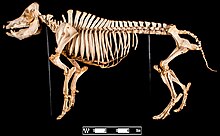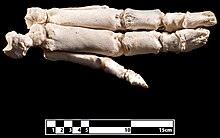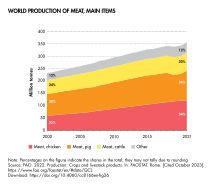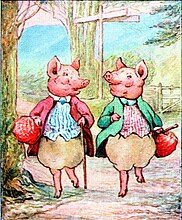Pig
| Pig | |
|---|---|
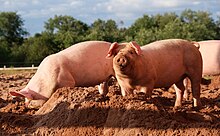
| |
| Domestic pigs | |
Domesticated
| |
| Scientific classification | |
| Domain: | Eukaryota |
| Kingdom: | Animalia |
| Phylum: | Chordata |
| Class: | Mammalia |
| Order: | Artiodactyla |
| Family: | Suidae |
| Genus: | Sus |
| Species: | S. domesticus
|
| Binomial name | |
| Sus domesticus Erxleben, 1777
| |
| Synonyms[1] | |
The pig (Sus domesticus), also called swine (pl.: swine) or hog, is an
Pigs are farmed primarily for meat, called pork. The animal's skin or hide is used for leather. China is the world's largest pork producer, followed by the European Union and then the United States. Around 1.5 billion pigs are raised each year, producing some 120 million tonnes of meat, often cured as bacon. Some are kept as pets.
Pigs have featured in human culture since Neolithic times, appearing in art and literature for children and adults, and celebrated in cities such as Bologna for their meat products.
Description
The pig has a large head, with a long snout strengthened by a special prenasal bone and a disk of
Pigs possess both
-
Skeleton
-
Skull
-
Bones of the foot
Evolution
Phylogeny
Domestic pigs are related to other pig species as shown in the cladogram, based on phylogenetic analysis using mitochondrial DNA.[15]
| Suidae |
| ||||||||||||||||||||||||||||||
Taxonomy
The pig is most often considered to be a subspecies of the wild boar, which was given the name Sus scrofa by Carl Linnaeus in 1758; following from this, the formal name of the pig is Sus scrofa domesticus.[16][17] However, in 1777, Johann Christian Polycarp Erxleben classified the pig as a separate species from the wild boar. He gave it the name Sus domesticus, still used by some taxonomists.[18] The American Society of Mammalogists considers it a separate species.[19]
Domestication in the Neolithic

Archaeological evidence shows that pigs were domesticated from wild boar in the Near East in or around the Tigris Basin,[21] being managed in a semi-wild state much as they are managed by some modern New Guineans.[22] There were pigs in Cyprus more than 11,400 years ago, introduced from the mainland, implying domestication in the adjacent mainland by then.[23] Pigs were separately domesticated in China, starting some 8,000 years ago.[24][25][26] In the Near East, pig husbandry spread for the next few millennia. It reduced gradually during the Bronze Age, as rural populations instead focused on commodity-producing livestock, but it was sustained in cities.[27]
Domestication did not involve reproductive isolation with population bottlenecks. Western Asian pigs were introduced into Europe, where they crossed with wild boar. There appears to have been interbreeding with a now extinct ghost population of wild pigs during the Pleistocene. The genomes of domestic pigs show strong selection for genes affecting behavior and morphology. Human selection for domestic traits likely counteracted the homogenizing effect of gene flow from wild boars and created domestication islands in the genome.[28][29] Pigs arrived in Europe from the Near East at least 8,500 years ago. Over the next 3,000 years they interbred with European wild boar until their genome showed less than 5% Near Eastern ancestry, yet retained their domesticated features.[30]
DNA evidence from subfossil remains of teeth and jawbones of Neolithic pigs shows that the first domestic pigs in Europe were brought from the Near East. This stimulated the domestication of local European wild boar, resulting in a third domestication event with the Near Eastern genes dying out in European pig stock. More recently there have been complex exchanges, with European domesticated lines being exported, in turn, to the ancient Near East.[31][32] Historical records indicate that Asian pigs were again introduced into Europe during the 18th and early 19th centuries.[25]
History
Columbian Exchange
Among the animals that the Spanish introduced to the
Feral pigs

Pigs have escaped from farms and gone feral in many parts of the world. Feral pigs in the southeastern United States have migrated north to the Midwest, where many state agencies have programs to remove them.[35][36][37] Feral pigs in New Zealand and northern Queensland have caused substantial environmental damage.[38][39] Feral hybrids of the European wild boar with the domestic pig are disruptive to both environment and agriculture, as they destroy crops, spread animal diseases including Foot-and-mouth disease, and consume wildlife such as juvenile seabirds and young tortoises.[40] Feral pig damage is especially an issue in southeastern South America.[41][42]
Reproduction
Physiology
Female pigs reach sexual maturity at 3–12 months of age and come into estrus every 18–24 days if they are not successfully bred. The variation in ovulation rate can be attributed to intrinsic factors such as age and genotype, as well as extrinsic factors like nutrition, environment, and the supplementation of exogenous hormones. The gestation period averages 112–120 days.[43]
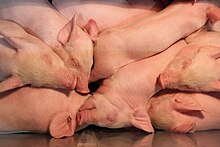
Archeological evidence indicates that medieval European pigs farrowed, or bore a litter of piglets, once per year.[50] By the nineteenth century, European piglets routinely double-farrowed, or bore two litters of piglets per year. It is unclear when this shift occurred.[51] Pigs have a maximum life span of about 27 years.[52]
Nest-building
A characteristic of pigs which they share with carnivores is
Nest-building occurs during the last 24 hours before the onset of farrowing, and becomes most intense 12 to 6 hours before farrowing.[54] The sow separates from the group and seeks a suitable nest site with well-drained soil and shelter from rain and wind. This provides the offspring with shelter, comfort, and thermoregulation. The nest provides protection against weather and predators, while keeping the piglets close to the sow and away from the rest of the herd. This ensures they do not get trampled on, and prevents other piglets from stealing milk from the sow.[55] The onset of nest-building is triggered by a rise in prolactin level, caused by a decrease in progesterone and an increase in prostaglandin; the gathering of nest material seems to be regulated more by external stimuli such as temperature.[54]
Nursing and suckling
Pigs have complex nursing and suckling behaviour.[56] Nursing occurs every 50–60 minutes, and the sow requires stimulation from piglets before milk let-down. Sensory inputs (vocalisation, odours from mammary and birth fluids, and hair patterns of the sow) are particularly important immediately post-birth to facilitate teat location by the piglets.[57] Initially, the piglets compete for position at the udder; then the piglets massage around their respective teats with their snouts, during which time the sow grunts at slow, regular intervals. Each series of grunts varies in frequency, tone and magnitude, indicating the stages of nursing to the piglets.[58]
The phase of competition for teats and of nosing the udder lasts for about a minute, ending when milk begins to flow. The piglets then hold the teats in their mouths and suck with slow mouth movements (one per second), and the rate of the sow's grunting increases for approximately 20 seconds. The grunt peak in the third phase of suckling does not coincide with milk ejection, but rather the release of oxytocin from the pituitary into the bloodstream.[59] Phase four coincides with the period of main milk flow (10–20 seconds) when the piglets suddenly withdraw slightly from the udder and start sucking with rapid mouth movements of about three per second. The sow grunts rapidly, lower in tone and often in quick runs of three or four, during this phase. Finally, the flow stops and so does the grunting of the sow. The piglets may dart from teat to teat and recommence suckling with slow movements, or nosing the udder. Piglets massage and suckle the sow's teats after milk flow ceases as a way of letting the sow know their nutritional status. This helps her to regulate the amount of milk released from that teat in future sucklings. The more intense the post-feed massaging of a teat, the more milk that teat later releases.[60]
-
Sows typically have 12–14 nipples.
-
A sow with suckling piglets
Teat order
In pigs,
Behaviour
Social

Pig behaviour is intermediate between that of other
Temperature control
Because of their relative lack of sweat glands, pigs often control their body temperature using behavioural thermoregulation. Wallowing, coating the body with mud, is a common behaviour.[9] They do not submerge completely under the mud, but vary the depth and duration of wallowing depending on environmental conditions.[9] Adult pigs start wallowing once the ambient temperature is around 17–21 °C (63–70 °F). They cover themselves in mud from head to tail.[9] They may use mud as a sunscreen, or to keep parasites away.[9] Most bristled pigs "blow their coat", meaning that they shed most of the longer, coarser stiff hair once a year, usually in spring or early summer, to prepare for the warmer months ahead.[65]
Eating, feeding, sleeping
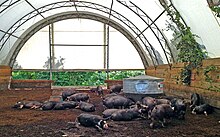
Where pigs are allowed to roam freely, they walk roughly 4 km daily, scavenging within a home range of around a hectare. Farmers in Africa often choose such a low-input, free-range production system.[66]
If conditions permit, pigs feed continuously for many hours and then sleep for many hours, in contrast to
Rooting is an instinctual comforting behaviour in pigs characterized by nudging the snout into something. It first happens when piglets are born to obtain their mother's milk, and can become a habitual, obsessive behaviour, most prominent in animals weaned too early. Pigs root and dig into the ground to forage for food. Rooting is also a means of communication.[68]
Intelligence
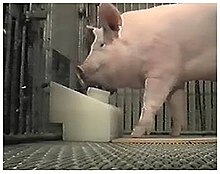
Pigs are noticeably intelligent, on a par with dogs. They distinguish each other as individuals; they spend time in play; and they form structured communities. They have good long-term memory, experience emotions, and change their behaviour in response to the emotional states of other pigs. In terms of experimental tasks, pigs can perform tasks that require them to identify the locations of objects; they can solve mazes; and they can work with a simple language of symbols. They display self-recognition in a mirror. Pigs have been trained to associate different sorts of music (Bach and a military march) with food and social isolation respectively, and could communicate the resulting positive or negative emotion to untrained pigs.[70][71] Pigs can be trained to use a joystick with their snout to select a target on screen.[69]
Senses

Pigs have
Pigs have a well-developed sense of smell; this is exploited in Europe where
Pests and diseases

Pigs are subject to many pests and diseases which can seriously affect productivity and cause death. These include parasites such as Ascaris roundworms, virus diseases such as the tick-borne African Swine Fever, bacterial infections such as Clostridium, arthritis caused by Mycoplasma, and stillbirths caused by Parvovirus.[81]
Some parasites of pigs are a public health risk as they can be transmitted to humans in undercooked pork. These are the pork tapeworm Taenia solium; a protozoan, Toxoplasma gondii; and a nematode, Trichinella spiralis. Transmission can be prevented by thorough sanitation on the farm; by meat inspection and careful commercial processing; and by thorough cooking, or alternatively by sufficient freezing and curing.[82]
In agriculture
Production
Pigs have been raised outdoors, and sometimes allowed to forage in woods or pastures. In industrialized nations, pig production has largely switched to large-scale intensive pig farming. This has lowered production costs but has caused concern about possible cruelty. As consumers have become concerned with the humane treatment of livestock, demand for pasture-raised pork in these nations has increased.[83] Most pigs in the US receive ractopamine, a beta-agonist drug, which promotes muscle instead of fat and quicker weight gain, requiring less feed to reach finishing weight, and producing less manure. China has requested that pork exports be ractopamine-free.[84] With a population of around 1 billion individuals, the domesticated pig is one of the most numerous large mammals on the planet.[85][86]
Like all animals, pigs are susceptible to adverse impacts from
-
Indoor pig farm, Sweden, 1911
-
Sow in stall with separate piglet balcony to prevent crushing, Germany, 1959
-
Free range pigs with field shelters, England, 2006
- FAOdata for 2021
-
Pork is tied with chicken as the most commonly consumed meat worldwide.
-
Pork production has grown substantially over the recent 60 years.
-
Production of pork worldwide, by country in 2021.
Breeds
Around 600
As pets

Vietnamese Pot-bellied pigs, a miniature breed of pig, have been kept as pets in the United States, beginning in the latter half of the 20th century.
Pigs are intelligent, social creatures. They are considered hypoallergenic and are known to do quite well with people who have the usual animal allergies. Since these animals are known to have a life expectancy of 15 to 20 years, they require a long-term commitment.
Given pigs are bred primarily as livestock and have not been bred as companion animals for very long, selective breeding for a placid or biddable temperament is not well established. Pigs have radically different
Economy
| Global pig stock | |
|---|---|
| in 2019 | |
| Number in millions | |
| 1. China (Mainland) | 310.4 (36.5%) |
| 2. European Union | 143.1 (16.83%) |
| 3. United States | 78.7 (9.26%) |
| 4. Brazil | 40.6 (4.77%) |
| 5. Russia | 23.7 (2.79%) |
| 6. Myanmar | 21.6 (2.54%) |
| 7. Vietnam | 19.6 (2.31%) |
| 8. Mexico | 18.4 (2.16%) |
| 9. Canada | 14.1 (1.66%) |
| 10. Philippines | 12.7 (1.49%) |
| World total | 850.3 |
| Source: UN Food and Agriculture Organization | |
Approximately 1.5 billion pigs are slaughtered each year for meat.[93]
The pork belly
In 2023, China produced more pork than any other country, 55 million tonnes, followed by the European Union with 22.8 million tonnes and the United States with 12.5 million tonnes. Global production in 2023 was 120 million tonnes.[96] India, despite its large population, consumed under 0.3 million tonnes of pork in 2023.[97] International trade in pork (meat not consumed in the producing country) reached 13 million tonnes in 2020.[98]
Uses
Products
Pigs are farmed primarily for meat, called pork. Pork is eaten in the form of pork chops, loin or rib roasts, shoulder joints, steaks, and loin (also called fillet). The many meat products made from pork include ham, bacon (mainly from the back and belly), and sausages.[99] Pork is further made into charcuterie products such as terrines, galantines, pâtés and confits.[100] Some sausages such as salami are fermented and air-dried, to be eaten raw. There are many types, the original Italian varieties including Genovese, Milanese, and Cacciatorino, with spicier kinds from the South of Italy including Calabrese, Napoletano, and Peperone.[101]
The hide is made into pigskin leather, which is soft and durable; it can be brushed to form suede leather. These are used for products such as gloves, wallets, suede shoes, and leather jackets.[102] In the 16th century, pig skin was the most popular book-binding material in Germany, though calf skin was more common elsewhere.[103]
-
Pork chops
-
Streaky or side bacon
-
Salami, a fermented and air-dried sausage, originally made in Italy
-
A 16th century book bound in pig skin
-
A woman's suede gloves, England, c. 1820
In medicine

Pigs, both as live animals and as a source of post-mortem tissues, are valuable animal models because of their biological, physiological, and anatomical similarities to human beings. For instance, human skin is very similar to the pigskin, therefore pigskin has been used in many preclinical studies.[105][106]
Pigs are good non-human candidates for organ donation to humans, and in 2021 became the first animal to successfully donate an organ to a human body.[107][108] The procedure used a donor pig genetically engineered not to have a specific carbohydrate that the human body considers a threat–Galactose-alpha-1,3-galactose.[109] Pigs are good for human donation as the risk of cross-species disease transmission is reduced by the considerable phylogenetic distance from humans.[110] They are readily available, and the danger of creating new human diseases is low as domesticated pigs have been in close contact with humans for thousands of years.[111]
Impact of pig husbandry
On public health
Pig farms can serve as reservoirs of viral diseases that are dangerous to humans and so contribute to their outbreaks in human populations.
On the environment

As with the other forms of meat, producing pork is more energy-intensive than plant-based foods, and it is associated with more
Intensive pig production is also associated with
On animal welfare

Intensive pig production involves practices such as castration, earmarking, tattooing for litter identification, tail docking, which are often done without the use of anesthetic.[120] [121] Teeth clipping of piglets is also done to curtail cannibalism, behavioural instability and aggression, and tail biting, which are induced by the cramped environment.[122][123] In indoor farming, pigs are allowed to be kept with less than one square meter of space per pig.[124]
Pigs often begin life in a
In culture
Pigs, widespread in societies around the world since
In literature, both for children[142] and adults, pig characters appear in allegories, comic stories, and serious novels.[136][143][144] In art, pigs have been represented in a wide range of media and styles from the earliest times in many cultures.[145] Pig names are used in idioms and animal epithets, often derogatory, since pigs have long been linked with dirtiness and greed,[146][147] while places such as Swindon are named for their association with swine.[148] The eating of pork is forbidden in Islam and Judaism,[149][150] but pigs are sacred in some other religions.[151][152]
-
Bronze pig sculpture, Zhou dynasty
-
Painting of Saint Anthony with a pig in background by Piero di Cosimo c. 1480
-
Canzone Sopra La Porcellina ("Song Upon the Piglet") by Giulio Cesare Croce, Bologna, 1622
-
Pigling Blandsetting out on his adventures
References
- ^ a b "Sus scrofa (wild boar)". Animal Diversity Web.
- ^ Lockhart, Kim. "American Wild Game / Feral Pigs / Hogs / Pigs / Wild Boar". gunnersden.com. Archived from the original on 23 August 2018. Retrieved 15 August 2012.
- ^ "Royal visit delights at the Three Counties Show". Malvern Gazette. 15 June 2007.
- ^ Bradford, Alina; Dutfield, Scott (5 October 2018). "Pigs, Hogs & Boars: Facts About Swine". LiveScience. Retrieved 4 March 2024.
- ^ Sumena, K. B.; Lucy, K. M.; Chungath, J.J.; Ashok, N.; Harshan, K. R. (2010). "Regional histology of the subcutaneous tissue and the sweat glands of large white Yorkshire pigs". Tamil Nadu Journal of Veterinary and Animal Sciences. 6 (3): 128–135.
- S2CID 28234765.
- ^ "Sweat like a pig?". Australian Broadcasting Corporation. 22 April 2008.
- ^ .
- PMID 25796346.
- ^ "Pros and Cons of Potbellied Pigs". Archived from the original on 17 March 2014. Retrieved 25 November 2017.
- PMID 27646534.
- PMID 32543654.
- PMID 35073880.
- ^ Wu, Gui-Sheng; Pang, Jun-feng; Zhang, Ya-Ping (2006). "Molecular phylogeny and phylogeography of Suidae". Zoological Research. 27 (2): 197–201.
- ^ "Taxonomy Browser". ncbi.nlm.nih.gov.
- doi:10.1016/j.jas.2003.10.006. Archived from the original(PDF) on 8 April 2011.
- .
- ^ "Explore the Database". www.mammaldiversity.org. Retrieved 21 August 2021.
- ISBN 978-1-83880-174-8.
- PMID 23180578.
our data suggest a narrative that begins with the domestication of pigs in Southwest Asia, at Upper Tigris sites including Çayönü Tepesi (Ervynck et al. 2001) and possibly Upper Euphrates sites including Cafer Höyük (Helmer 2008) and Nevalı Çori (Peters et al. 2005)
- S2CID 85302206.
- PMID 19706455.
- S2CID 225700922.
- ^ PMID 10747069.
- ^ Jean-Denis Vigne; Anne Tresset; Jean-Pierre Digard (3 July 2012). History of domestication (PDF) (Speech).
- ^ Price, Max (March 2020). "The Genesis of the Near Eastern Pig". American Society of Overseas Research. Archived from the original on 10 February 2022. Retrieved 8 August 2021.
- S2CID 205350534.
- .
- PMID 31405970.
- ^ BBC News, "Pig DNA reveals farming history" 4 September 2007. The report concerns an article in the journal PNAS
- PMID 17855556.
- .
- ^ II.G.13. – Hogs. Archived 20 December 2007 at the Wayback Machine
- ^ "Feral Hogs in Missouri". Missouri Department of Conservation. Archived from the original on 8 March 2017. Retrieved 7 March 2017.
- ^ "Feral Hog Hunting Regulations". agfc.com. Archived from the original on 22 February 2017. Retrieved 7 March 2017.
- ^ "Feral Hog Management". Georgia DNR – Wildlife Resources Division. Archived from the original on 8 March 2017. Retrieved 8 March 2017.
- ^ Yoon, Carol Kaesuk (2 December 1992). "Alien Species Threaten Hawaii's Environment". The New York Times.
- ^ "Introduced Birds and Mammals in New Zealand and Their Effect on the Environment – NZETC". nzetc.org.
- ^ "World's 100 most destructive species named". The Independent. 21 November 2004. Retrieved 7 March 2017.
- ^ Bauru; Marília (12 April 2013). "Autorização para abate do javaporco tranquiliza produtores em Assis, SP". Bauru e Marília.
- ^ "IBAMA authorizes capture and slaughter of 'javaporcos' – Folha do Sul Gaúcho". Archived from the original on 3 July 2017.
- ^ "Feral Hog Reproductive Biology". 16 May 2012. Archived from the original on 22 November 2015.
- ^ "G2312 Artificial Insemination in Swine: Breeding the Female". University of Missouri Extension. Archived from the original on 8 March 2017. Retrieved 7 March 2017.
- ^ "The Female – Swine Reproduction". livestocktrail.illinois.edu. Archived from the original on 10 February 2022. Retrieved 7 March 2017.
- PMID 3517318.
- PMID 22958877.
- ^ PMID 29794023.
- PMID 28628266.
- ^ Ervynck, Anton; Dobney, Keith (2002). "A Pig for all Seasons? Approaches to the Assessment of Second Farrowing in Archaeological Pig Populations". Archaeofauna (11): 7–22.
- ISBN 978-0-470-99860-1.
- PMID 32361879.
- ^ a b c Clutton-Brock, Juliet (1987). A Natural History of Domesticated Mammals. Cambridge: Cambridge University Press. pp. 73–74.
- ^ S2CID 9742677.
- .
- .
- S2CID 31788525.
- PMID 8226386.
- .
- S2CID 12493158.
- PMID 4733757.
- .
- ^ "Tail docking and tail biting in pigs". Animal Husbandry Development Board. Retrieved 4 March 2024.
- ^ "Pig Health- Tail Biting". National Animal Disease Information Service. Archived from the original on 13 January 2013. Retrieved 4 March 2024.
- ^ "Blowing Coat – Mini Pig Shedding FAQ". americanminipigassociation.com. 2 April 2016.
- PMID 23497587.
- S2CID 84886946.
- ^ "Rooting & Nudging Behaviors in Mini Pigs". americanminipigassociation.com. 8 June 2016.
- ^ PMID 33679560.
- ^ Colvin, Christina M.; Marino, Lori. "Signs of Intelligent Life". Natural History Magazine. Retrieved 3 June 2019.
- ^ Angier, Natalie (9 November 2009). "Pigs Prove to Be Smart, if Not Vain". The New York Times. Retrieved 28 July 2010.
- ^ "Animalbehaviour.net (Pigs)". Archived from the original on 17 March 2012. Retrieved 9 December 2012.
- ^ "Animalbehaviour.net (Sheep)". Archived from the original on 26 December 2012. Retrieved 9 December 2012.
- .
- ^ Sullivan, Walter (24 March 1982). "Truffles: Why Pigs Can Sniff Them Out". The New York Times.
- PMID 36387395.
- ISBN 978-1-119-23276-6.
- ISBN 978-0-85199-397-3.
- S2CID 4386919.
- .
- ^ "Disease A-Z for Pigs". NADIS Animal Health Skills. Retrieved 15 February 2024.
- PMID 9501363.
- ^ Strom, Stephanie (2 January 2014). "Demand Grows for Hogs That Are Raised Humanely Outdoors". The New York Times. Retrieved 15 April 2015.
- ^ Charles, Dan (14 August 2015). "A Muscle Drug For Pigs Comes Out Of The Shadows". NPR.
- ^ "PSD Online". fas.usda.gov.
- ^ Swine Summary Selected Countries Archived 29 March 2012 at the Wayback Machine, United States Department of Agriculture, Foreign Agricultural Service, (total number is Production (Pig Crop) plus Total Beginning Stocks
- S2CID 58951606.
- PMID 36944938.
- ^ "The Livestock Conservancy". livestock Conservancy. Retrieved 7 March 2017.
- ^ "Taking good care of Ellegaard Göttingen Minipigs®" (PDF). Ellegaard Göttingen Minipigs. Archived from the original (PDF) on 19 April 2016. Retrieved 2 July 2018.
- ^ "Info/Resource - Pigs 4 Ever - Gifts, supplies and resources for Pot-Bellied Pigs". pigs4ever.com. Retrieved 11 October 2020.
- ^ "Spay and Neuter – American Mini Pig Association". americanminipigassociation.com.
- ^ "FAOSTAT". fao.org. Retrieved 25 October 2019.
- ^ a b Davey, Monica (30 July 2011). "Trade in Pork Bellies Comes to an End, but the Lore Lives". The New York Times.
- ^ Garner, Carley (13 January 2010). "A Crash Course in Commodities". FT Press. Archived from the original on 21 October 2013. Retrieved 6 December 2011.
- ^ "Global pork production in 2022 and 2023, by country". Statista. Retrieved 15 February 2024.
- ^ "Consumption volume of pork in India from 2013 to 2023". Statista. Retrieved 15 February 2024.
- ^ Ter Beek, Vincent (13 December 2023). "The remarkable dynamics of global pig meat trade". Pig Progress. Retrieved 15 February 2024.
- ^ "Pork Cuts". National Pork Board. Retrieved 15 February 2024.
- ISBN 978-0-19-967733-7.
- ISBN 978-0-19-967733-7.
- ^ "Pig leather". Leather Dictionary. Retrieved 15 February 2024.
- ^ "Cover to Cover: Exposing the Bookbinder's Ancient Craft". The University of Adelaide. Retrieved 6 March 2024.
- PMID 26442109.
- ^ Herron, Alan J. (5 December 2009). "Pigs as Dermatologic Models of Human Skin Disease" (PDF). ivis.org. DVM Center for Comparative Medicine and Department of Pathology Baylor College of Medicine Houston, Texas. Retrieved 27 January 2018.
- ^ Liu, J.; Kim, L.; Madsen, T.; Bouchard, G. F. "Comparison of Human, Porcine and Rodent Wound Healing With New Miniature Swine Study Data" (PDF). sinclairresearch.com. Sinclair Research Centre, Auxvasse, MO, USA; Veterinary Medical Diagnostic Laboratory, Columbia, Missouri. Archived from the original (PDF) on 27 January 2018. Retrieved 27 January 2018.
- ^ "Successful pig-to-human kidney transplant a "transformative moment"". www.yahoo.com. 20 October 2021. Retrieved 2 November 2021.
- ^ Lapid, Nancy (20 October 2021). "U.S. surgeons successfully test pig kidney transplant in human patient". Reuters. Retrieved 2 November 2021.
- ^ "Progress in Xenotransplantation Opens Door to New Supply of Critically Needed Organs". NYU Langone News. Retrieved 2 November 2021.
- PMID 12612110.
- ^ Taylor, L. (2007) Xenotransplantation. Emedicine.com
- ^ PMID 35392655.
- PMID 27350259.
- ^ "2009 swine flu pandemic originated in Mexico, researchers discover". Science Daily. 27 June 2016. Archived from the original on 14 March 2020. Retrieved 18 March 2020.
- ^ "Japanese encephalitis". World Health Organization. December 2015. Archived from the original on 13 July 2017. Retrieved 29 October 2017.
- ISBN 978-92-5-138262-2.
- ^ PMID 17384784.
- .
- ^ "Agriculture". www.epa.gov. 19 March 2015. Retrieved 23 April 2017.
- ^ Cutler, R; Holyoake, P (2007). "The Structure and Dynamics of the Pig Meat Industry, prepared for Department of Agriculture, Fisheries and Forestry" (PDF). agriculture.gov.au.
- ^ "Video Gallery". aussiepigs.com. Archived from the original on 2 June 2019. Retrieved 2 June 2019.
- ^ a b "Industry Focus". australianpork.com.au. Australian Pork Limited.
- .
- ^ "Key figures for pig accommodation in England – legislative requirements" (PDF). AHDB Pork. Archived from the original (PDF) on 3 June 2019.
- ^ Cutler, R; Holyoake, P (2007). "The Structure and Dynamics of the Pig Meat Industry, prepared for Department of Agriculture, Fisheries and Forestry" (PDF).
- ^ "Opinion on Free Farrowing Systems" (PDF). Farm Animal Welfare Committee. Archived from the original (PDF) on 3 April 2019.
- ^ "Farrowing Fact Sheet". Viva! - The Vegan Charity. 6 January 2016. Archived from the original on 1 October 2020. Retrieved 3 June 2019.
- ^ "Pig welfare". ciwf.org.uk. Retrieved 3 June 2019.
- ^ "Revisiting Weaning Age Trends, Dynamics". Nationalhogfarmer.com. 15 October 2005. Retrieved 28 July 2017.
- ^ "Pre-weaning mortality". pigprogress.net. Pig Progress. 13 July 2010.
- ^ Model code of practice for the welfare of animals: Pigs, Primary Industries Report Series third edition. 2008.
- ^ "Best of British? The Pig Industry Exposed" (PDF). Animal Aid.
- ^ "Fact Sheet – 'Reproductive Health'" (PDF). australianpork.com.au. Australian Pork Limited. 2012. Archived from the original (PDF) on 30 March 2019. Retrieved 2 June 2019.
- ^ Greenaway, Twilight (1 October 2018). "'We've bred them to their limit': death rates surge for female pigs in the US". The Guardian. Retrieved 17 November 2018.
- S2CID 193116973.
- ^ .
- ^ Newey, Adam (8 December 2014). "Nuremberg, Germany: celebrating the city's sausage". The Daily Telegraph.
- ^ "Eventi: Pane e salame" (in Italian). Istituzione Biblioteche Bologna. August 2009. Retrieved 31 December 2019.
- ^ Virbila, S. Irene (7 August 1988). "Fare of the Country; Mortadella: Bologna's Bologna". The New York Times.
- ISBN 9781780647944.
- ^ The Joy of Pigs/ Pigs as Pets. PBS Nature. Accessed June 2017.
- JSTOR 41386323.
- ^ Mullan, John (21 August 2010). "Ten of the best pigs in literature". The Guardian.
- ^ Bragg, Melvyn. "Topics - Pigs in literature". BBC Radio 4. Retrieved 1 January 2020.
Animal Farm ... Sir Gawain and the Green Knight ... The Mabinogion ... The Odyssey ... (In Our Time)
- ^ "Pig". Metropolitan Museum of Art. Retrieved 2 January 2020.
- ^ "Fine Swine". The Daily Telegraph. 2 February 2001.
- ISBN 0816641838.
- ISBN 0192831313.
- Qur'an2:173, 5:3, 6:145, and 16:115.
- ^ Leviticus 11:3–8
- ISBN 978-0-14-341421-6.
- ^ Bonwick, James (1894). "Sacred Pigs". Library Ireland.

